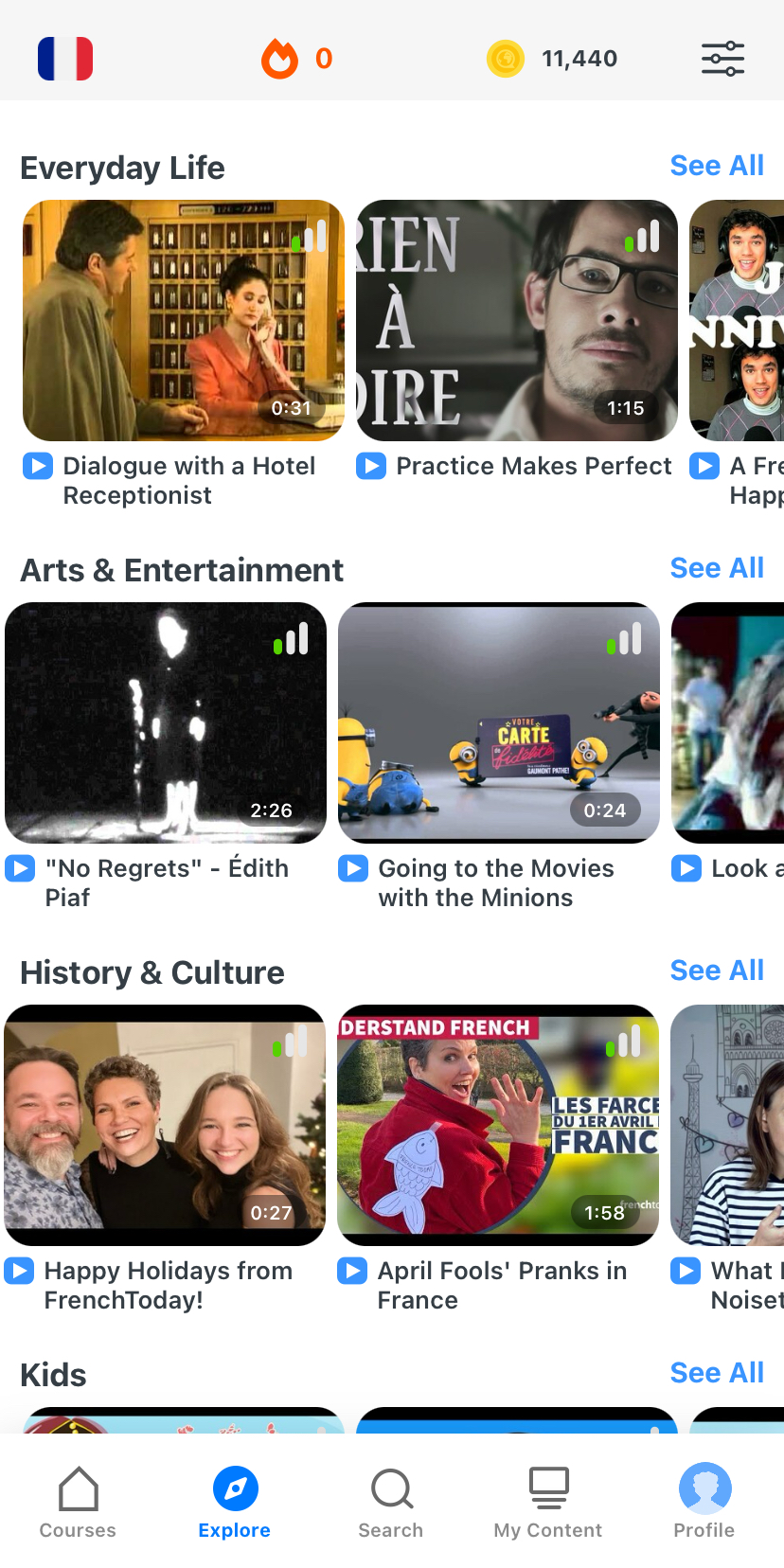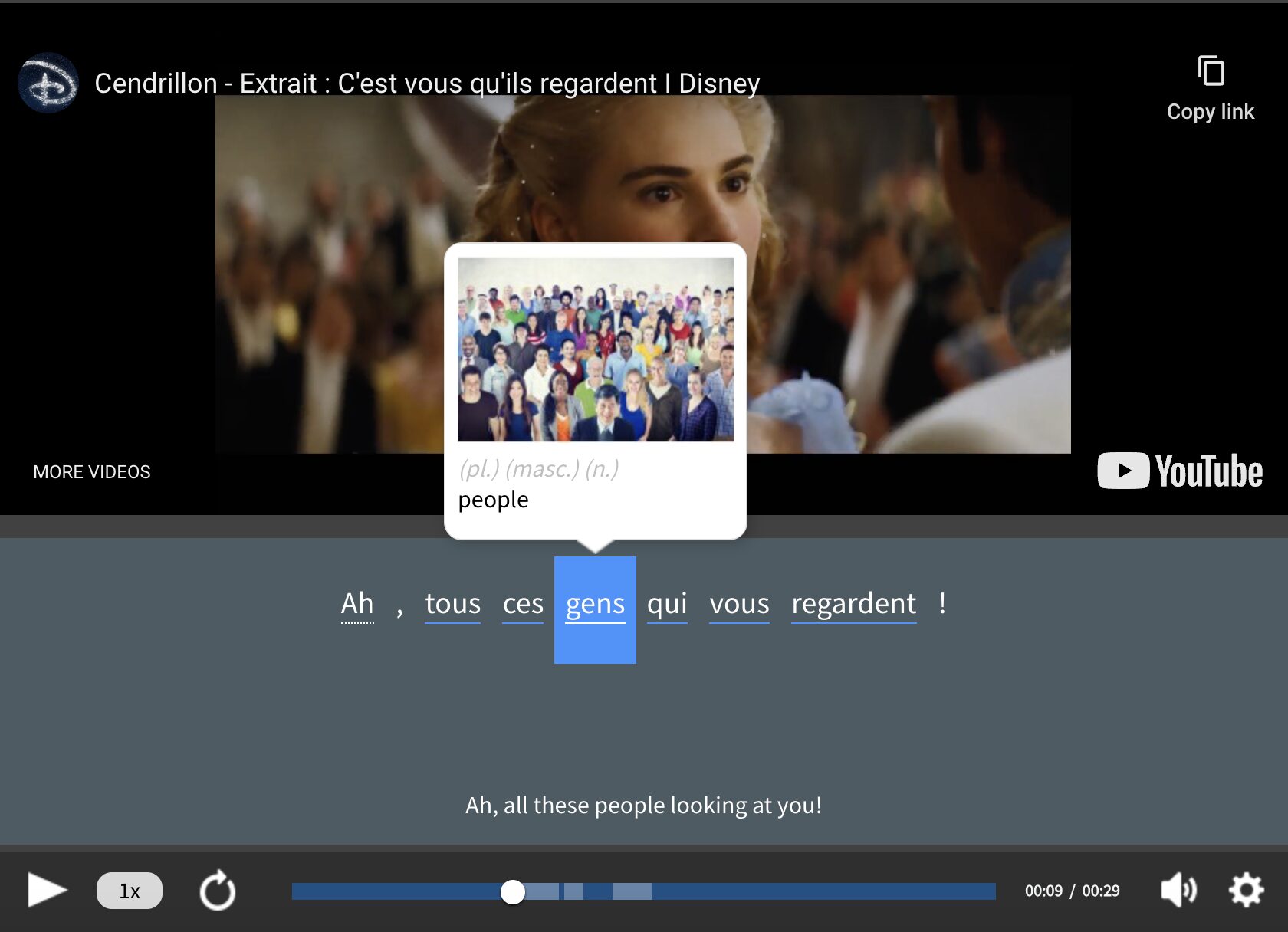Contents
- 1. Amande/amende
- 2. Au/aux/eau
- 3. Aussi tôt/aussitôt
- 4. Auteur/hauteur
- 5. Avocat/avocat
- 6. Boue/bout
- 7. Cent/sang/sens/sans
- 8. Chouette/chouette
- 9. Compte/comte/conte
- 10. Dans/dent
- 11. Été/été
- 12. Filtre/philtre
- 13. Foi/foie/fois
- 14. Guère/guerre
- 15. Lac/laque
- 16. Leur/leurre/l’heure
- 17. Mer/maire/mère
- 18. Mur/mûr/mûre
- 19. Pair/paire/père
- 20. Pâtes/pâte/pattes
- 21. Plus tôt/plutôt
- 22. Reine/renne
- 23. Sel/selle/celle
- 24. Tour/tour
- 25. Vert/vers/ver/verre
- How to Practice French Homophones
- And One More Thing...
25 Common French Homophones and Their Meanings

Homophones are words that sound alike but have different meanings. But when it comes to listening comprehension, they can pose a big problem for French learners.
While some of that is just the fun of French, we’re going to greatly reduce your chances of getting into any embarrassing situations by going over some of the most common and confusing homophones. Once you have these homophones on lock, you’ll not only be able to identify them, but even use them to make French puns, play with words and practice your writing.
Download: This blog post is available as a convenient and portable PDF that you can take anywhere. Click here to get a copy. (Download)
1. Amande/amende
une amande — an almond
une amende — a fine
Est-ce que je peux payer l’amende en amandes?
(Can I pay the fine in almonds?)
Spoken, these two can get switched around easily, especially since they’re both feminine. Written, they’re easy to tell apart, thanks to the vowel differences! Just remember that by paying une amende you’re making “amends.” And as for des amandes, those are just delicious.
2. Au/aux/eau
au — contraction of à and le
aux — contraction of à and les
eau — water
Au contraire! Il y a plein d’eau aux eaux!
(To the contrary! There is lots of water at the spa!)
Also the same as pronouncing a closed o in French, these three all make the exact same sound, much like the “o” in the word “cold.” Luckily, you’ll get pretty accustomed to au and aux, using them when you contract à and les or à and le (which is basically all the time). Eau will become intuitive as well, and when someone asks for un verre d’eau, only one of these homophones makes sense.
And yes, there is a fourth homophone here. Eaux is an old term for a spa, so you’re welcome to include that in your vocabulary vault!
3. Aussi tôt/aussitôt
aussi tôt — too early, as soon (as possible)
aussitôt — immediately
Aussitôt que je suis arrivé chez moi, ma mère m’a demandé de faire la vaisselle aussi tôt que possible.
(Immediately after I arrived at my house, my mom asked me to do the dishes as soon as possible.)
This one haunted me for some time, and you may have gotten to this point still thinking these two were the same word. Don’t feel bad, many a French learner has gone through this. These have a similar meaning, making them slightly tricky.
Remember that as two words—aussi tôt—it’s a literal translation using the separate French words for “also/too” and “early.” Whereas aussitôt together becomes a whole new word!
4. Auteur/hauteur
un auteur — an author
une hauteur — a height
L’auteur a peur des hauteurs.
(The author is afraid of heights.)
This pair is easy on the eyes, but not so easy on the ears. The root word of une hauteur is haut (high), an adjective you may be familiar with. Luckily, there is a way to tell a difference between these when heard. The h in hauteur is what is called an h aspiré, meaning that when it comes to liaisons and contractions, it acts like a consonant. So you’ll have l‘auteur with the contraction, but le hauteur pronounced as two separate words! Train them ears!
5. Avocat/avocat
un avocat — an avocado
un avocat — a lawyer
Il y a un avocat qui représente des avocats.
(There is a lawyer who represents avocados.)
This one is just goofy. It never fails to crack me up, and it will make you hesitate before asking someone if they’re un avocat. But don’t worry here too much. The context will likely present itself (and if not for some reason, everyone will get a good laugh).
6. Boue/bout
la boue — the mud
le bout — the tip
Je ne mets que le bout du doigt dans la boue.
(I put only my fingertip in the mud.)
Le bout doesn’t mean “tip” as in what you’d give a waiter at a restaurant (which isn’t customary in France, anyway). This is talking about a physical tip (tip of the iceberg, tip of the nose). These two are pretty easy to distinguish from one another; you’ve got the masculine and feminine going for you, as well as spelling differences.
7. Cent/sang/sens/sans
cent — one hundred
sang — blood
sens — first-person singular of sentir (to feel)
sans — without
Sans sang, je me sens cent pour cent mort.
(Without blood, I feel one hundred percent dead.)
Ahhhhh! There are four! This is probably one of the more annoying sets of homophones, but we’re going to get them down once and for all. You’re likely rather familiar with these words, and probably don’t get them too confused as it is, but when you start getting deep into audio resources it’s good to be aware that these fairly common words have the same sound.
They’re also a good lesson on French pronunciation; it’s a bit crazy to have words with such different spellings sound so similar. The saving grace with this set is that cent is an adjective, sang is a noun, sens is a conjugated verb form and sans is a preposition.
8. Chouette/chouette
une chouette — an owl
chouette — cool, nice
Cette chouette est chouette!
(This owl is cool!)
If you want to remember this one just by convincing yourself that owls are the coolest animals ever, then go right ahead. In all reality, you’re likely (unless you’re using your French to talk about animals) to use the adjective version of this one anyway. But if you hear an une or la before the word chouette, then you know something is hooting somewhere.
9. Compte/comte/conte
un compte — an account
un comte — a count (nobleman)
un conte — a story
J’ai lu un conte sur un comte qui a ouvert un compte.
(I read a story about a count who opened an account.)
Oh spelling changes galore! Although these have slight changes with the m and n (making them nasal), they sound incredibly similar. It’s just so convenient that all of these are masculine, isn’t it? To remember un compte, think of the verb compter (to count).
But don’t confuse this with un comte, which translates into English as a count, like Count Olaf (read “Les désastreuses aventures des orphelins Baudelaire” if you’re not hip to the reference). Then, for un conte, think of the second half of the verb raconter (to tell about).
10. Dans/dent
dans — in
un dent — a tooth
J’ai une puce électronique dans mon dent.
(I have a microchip in my tooth.)
Since dans is a preposition, and you’ll always see dent(s) with a definite or indefinite article, this one won’t get you dans too much trouble.
11. Été/été
été — summer
été — the past participle of être (to be)
Si mon anniversaire avait été en été, on l’aurait fêté à la piscine.
(If my birthday had been in summer, we would have celebrated it at the pool.)
Since été, the past participle version, will always be accompanied by a conjugated avoir (to have), this one is kind of in the bag. But it’s a confusing set of homophones when you’re first starting out.
12. Filtre/philtre
un filtre — a filter
un philtre — a potion
On a besoin de filtres spéciaux pour faire ce philtre.
(You need special filters to make this potion.)
Unless you’re watching a Harry Potter movie, when you hear someone say this, you can assume they’re talking about a filter. Though if you’re trying to remember how to spell each one, remember that filtre uses the same letters as its English translation (filter), just with the last two letters switched around.
13. Foi/foie/fois
la foi — faith
le foie — liver
une fois — a time
Une fois, j’ai mis toute ma foi en foie gras.
(One time, I put all my faith in foie gras.)
If you travel to France and are down for sampling their cuisine, then you’ll come across du foie (liver) more than you’re probably used to. This refers to both the food and the liver inside of you. This is a set you’ll just have to learn (so get those flashcards out!).
Though to put your mind at ease, unless you’re at a doctor’s office, restaurant or church, the best guess is fois, as it’s an extremely common word.
14. Guère/guerre
guère — hardly
la guerre — war
Ce n’était guère une guerre.
(It was hardly a war.)
The best homophones are the ones where one is a noun and the other…isn’t. Guère is a great word to know, especially when reading. La guerre isn’t really at risk of being confused with the similar-sounding adverb, but hey, you just got a useful vocabulary word out of this!
15. Lac/laque
le lac — lake
la laque — gloss or hairspray (or lacquer)
J’ai oublié ma laque au lac!
(I forgot my hairspray at the lake!)
To remember the spelling of these, just remember the English word “lacquer,” the stuff you put on wood or nails that makes them shine. Laque is spelt similarly and has the same meaning, changing the exact definition depending on the context (hair, nails, walls, etc.). From there, remembering this pair isn’t too bad.
16. Leur/leurre/l’heure
leur — possessive pronoun (their), indirect object pronoun (them)
un leurre — a delusion/illusion
l’heure — the hour
Leur leurre est que l’heure est toujours fausse.
(Their delusion is that the time is always wrong.)
These three homophones have pretty different contexts and uses, but be aware of them, especially since l’heure and leur are used all the time. Un leurre, not as much, unless you suffer from a lot of delusions about how bad your French is (I promise it’s not as bad as you think).
17. Mer/maire/mère
La mer — the sea
Le maire — the mayor (la maire is also possible in some regions)
La mère — the mother
La mère du maire habite à côté de la mer.
(The mother of the mayor lives next to the sea.)
Here’s another tricky one for you. I like to think of le maire as la mère of the city, and as for la mer, I think of this song. Since all of these are commonly used, sometimes you’ll have to use your (amazing) instincts.
18. Mur/mûr/mûre
un mur — a wall
mûr(e) — ripe
une mûre — a blackberry
Quelqu’un a lancé une mûre mûre au mur.
(Someone threw a ripe blackberry at the wall.)
Unfortunately, the accent circumflex on mûr and mûre don’t make a difference with pronunciation, making this kind of a tricky one. Context is going to be key with this one. Luckily, we don’t eat both walls and blackberries! As for the adjective mûr, it can be quite easy to remember if you relate it back to the word for “blackberry.” We eat those when they’re ripe, don’t we?
19. Pair/paire/père
un pair — a peer
une paire — a pair
un père — a father
Mon père et son pair font une bonne paire.
(My dad and his peer make a good pair.)
Luckily, the French word for “pear” is poire and not another homophone, or we would be in real trouble here. It’s hard to get un pair and une paire straight, especially since (don’t cry) the adjective form of un pair is pair (meaning even, as in number), and the feminine form of this is paire.
So really the example sentence could have been much more painful. You should be able to identify when someone is talking about their dad, but truth be told, they could be talking about their peer. Trust your judgement on that; I believe in you.
As for une paire, a lot of the time it will be followed by de + [noun], like une paire des bottes (a pair of boots).
20. Pâtes/pâte/pattes
les pâtes — pasta
la pâte — dough
les pattes — paws
Mettez vos pattes sur la pâte pour faire des pâtes.
(Put your paws on the dough to make the pasta.)
If you think of how pâtes and pâte relate, then this one is a cinch! Pasta is made of dough, and though the word pâte is used in general for dough, you can still think of pâtes as a plural for pâte because you would have to use multiple pieces of dough to make pasta. As for des pattes, animals tend to have paws and not pasta or dough (unless it’s a thieving raccoon).
21. Plus tôt/plutôt
plus tôt — earlier
plûtot — rather
Je voudrais partir plus tôt plûtot qu’arriver plus tard.
(I would like to leave earlier rather than arrive late.)
Much like the homophones aussi tôt and aussitôt, this is another pair that you may not have been distinguishing between. There is more of a spelling difference here, though, and while they may be difficult to distinguish in a listening comprehension situation, plus tôt is a direct translation to “more early” or “earlier,” whereas plutôt is missing the s and becomes its own special little word for “rather.”
22. Reine/renne
La reine — the queen
Le renne — the reindeer
Elle est la reine des rennes.
(She is the queen of the reindeer.)
This one is more for fun than practicality. You’ve got a few ways to distinguish these: masculine vs. feminine, a definite advantage of context and the spelling is very different if you’re seeing them written! But it’s still fun to say la reine des rennes.
23. Sel/selle/celle
le sel — salt
la selle — saddle
celle — demonstrative pronoun
Celle qui a mis le sel sur la selle sera puni!
(She who put the salt on the saddle will be punished!)
Don’t worry too much about la selle, as it will likely be referred to in an already horse-related context. And sel, being salt and all, is a staple—both in language and in the kitchen. As for celle, the demonstrative pronoun, you’re sure to hear it, and even use it.
Demonstrative pronouns refer to nouns that have already been mentioned in a sentence (as in “those,” “them,” “these,” “that,” etc.). Celle refers specifically to a feminine singular noun. The others are celui (masculine singular), ceux (masculine plural) and celles (feminine plural).
24. Tour/tour
la tour — the tower
le tour — the turn, the perimeter
Attention! C’est à mon tour de faire le tour de la tour.
(Be careful! It’s my turn to walk around the tower.)
Really try to remember these definitions with the le and la in mind, otherwise you may find yourself lost in the tower!
25. Vert/vers/ver/verre
vert — green
vers — around, toward
un ver — worm
un verre — a glass
En buvant mon verre de vin, j’ai vu un ver vert vers la maison!
(While drinking my glass of wine, I saw a green worm around the house!)
Like some of the previous homophone sets we’ve mentioned, this one is rather simple to keep straight. You’ve got an adjective, vert, a preposition, vers, and nouns ver and verre, making it all divers (diverse). See! You can rhyme with some of these!
How to Practice French Homophones
The old-school method (with a twist)
We can’t have a post about vocabulary without mentioning flashcards, can we? They really are a great resource, but it’s okay if they’re not your thing.
The important thing to consider if you do make your own flashcards for homophones is that you need to keep them within their groups. If you learn how these homophones sound, then the rest gets easier.
Make flashcards with each set of homophones on one side, whether that’s two or three (for four you may want to break it up into two flashcards), and then the definitions of each on the other side.
To help keep things clear in your mind, make sure you color code them with their corresponding definitions. You can also underline the spelling changes or draw little pictures or symbols to help you even further. Then study…study…study!
Test your knowledge
You may already know more of these than you’re giving yourself credit for. And with homophones being kind of a tricky vocabulary module, quizzes can be a great way to test your knowledge and learn the pairings along the way. Check out these homophone quizzes for a fun test of your skills:
1. Sporcle.com
2. Quizz.biz
Use your word play skills
If you either want more of a challenge or something to exercise your brain with, then trying to make a sentence using homophones is a fun method. Take two (or sometimes three or four) homophones and make one single sentence with them.
The only rules are that you have to use them correctly, and all in one (if possible, a 140-character tweet-sized) sentence.
Homophones aren’t something to stress over, especially since we just went through most of the major ones.
But if you can get these down, you’ll definitely start noticing them in your listening practice.
These can be a fun and interesting way to introduce new vocabulary into your day and get you asking questions about why certain things are pronounced the way they are!
Download: This blog post is available as a convenient and portable PDF that you can take anywhere. Click here to get a copy. (Download)
And One More Thing...
If you're like me and enjoy learning French through movies and other media, you should check out FluentU. With FluentU, you can turn any subtitled content on YouTube or Netflix into an engaging language lesson.
I also love that FluentU has a huge library of videos picked specifically for French learners. No more searching for good content—it's all in one place!

One of my favorite features is the interactive captions. You can tap on any word to see an image, definition, and examples, which makes it so much easier to understand and remember.
And if you're worried about forgetting new words, FluentU has you covered. You'll complete fun exercises to reinforce vocabulary and be reminded when it’s time to review, so you actually retain what you’ve learned.
You can use FluentU on your computer or tablet, or download the app from the App Store or Google Play. Click here to take advantage of our current sale! (Expires at the end of this month.)










